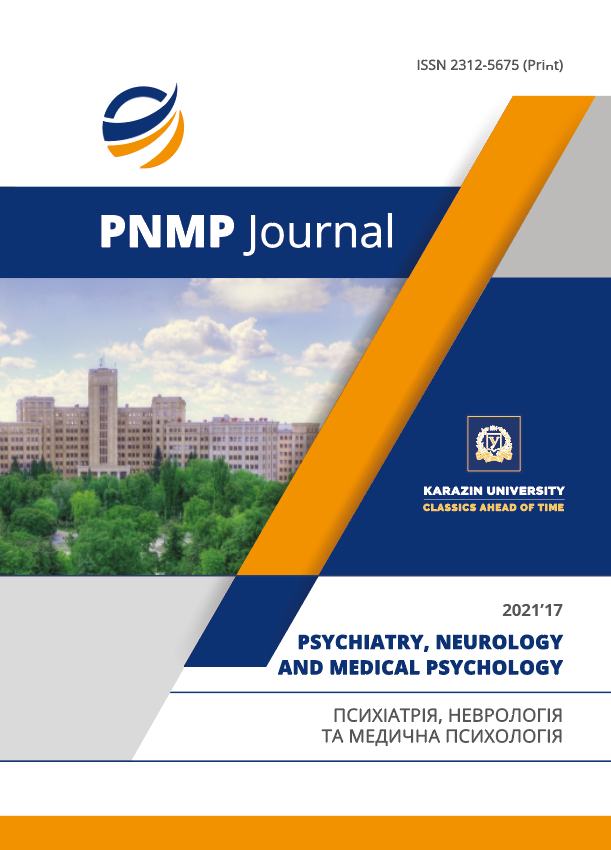Results of the study of the frequency of new cases of non-psychotic mental disorders in students of higher education institutions
Abstract
Topicality. The trend of increasing mental disorders, especially due to borderline disorders, which has been observed in recent years,
requires the search for new approaches to maintaining mental health, prevention and, in particular, early diagnosis of non-psychotic
mental disorders (NPD).
The aim of the study. Investigate the frequency and structure of new cases of non-psychotic mental disorders in students of higher
education institutions.
Materials and methods. During 2015-2017, we conducted a continuous comprehensive survey of 1,235 students in compliance
with the principles of bioethics and deontology. Applied methods: clinical, clinical-psychopathological, clinical-epidemiological, clinicalanamnestic, experimental-psychological and statistical. The sample did not have signifi cant diff erences in gender and age, place of
residence, form of education. The survey was conducted in the intersessional period.
Results. Evaluation of primary cases of NPD, which were detected during re-examination, was performed among practically healthy
students based on the results of the fi rst examination and compared the data with the structure of NPD, which we diagnosed in the entire
cohort of subjects studied in the fi rst cross section.
The majority of students in whom the initial examination revealed no mental pathology remained virtually healthy after a year (858
people, 93.46%). Analyzing the structure of NPD, which arose during this period in this contingent, was narrower in comparison with
the identifi ed patients at the initial examination. Mainly, NPD were represented by aff ective disorders (F30.0, F32.0, F34.0) and neurotic,
stress-related and somatoform disorders (F40.1, F41.2, F42.0, F43.20, F43 .21, F43.22). An interesting fact was that in the structure of the
NPD detected during the re-examination there were no other, than previously diagnosed during the initial examination, the category of
mental pathology according to ICD-10.
Conclusions. Thus, mainly NPD of aff ective (1.2%) represents the structure of new cases of NPR diagnosed during the year of study
and neurotic registers (5.34%) (In the ratio ≈ 1/5, respectively), so other forms of mental pathology occur more quickly in period before the
beginning of training or at long training. Therefore, it is advisable to focus on psychoprophylactic measures to increase the stress resistance
of students and their adaptive capabilities.
Downloads
References
Lazos H.P. Post-traumatic growth: theoretical models, new perspectives for practice. Aktualni problemy psykholohii. 2016. Vol. 1(45), pp. 120-127. [In Ukr.]
Brailovskaia J., Schönfeld P., Zhang X.C. [et al.] A cross-cultural study in Germany, Russia, and China: are resilient and social supported students protected against depression, anxiety, and stress? Psychol Rep. 2018. Vol. 121(2), pp. 265-81. https://doi.org/10.1177/0033294117727745
Kozhyna H.M., Markova M.V., Marakushyn D.I. [et al.] A comprehensive system of psychoprophylaxis for the development of maladaptation in students in the first years of study. Arkhiv psykhiatrii. 2016. Vol. 22(4), pp. 51-55. [In Ukr.] http://nbuv.gov.ua/UJRN/apsuh_2016_22_4_12
Velten J., Bieda A., Scholten S. [et al.] Lifestyle choices and mental health: a longitudinal survey with German and Chinese students. BMC Public Health [Internet]. 2018[cited 2020 Aug 19]; 18(1):632. Available from: https://www.ncbi.nlm.nih.gov/pmc/articles/PMC5956886/pdf/12889_2018_Article_5526. pdf https://doi.org/10.1186/s12889-018-5526-2
Lukat J, Margraf J, Lutz R, van der Veld WM, Becker ES. Psychometric properties of the positive mental health scale (PMH-scale). BMC Psychol [Internet]. 2016 [cited 2020 Sep 19];4:8. Available from: https://www.ncbi.nlm.nih.gov/pmc/articles/PMC4748628/pdf/40359_2016_Article_111.pdf https://doi.org/10.1186/s40359-016-0111-x
Yurtsenyuk OS Prevalence and complex treatment of neurotic, stress-related and somatoform disorders in students of diff erent courses and specialties. Psychiatry, neurology and medical psychology. 2020. No 13, рр. 43-48 [In Ukr.] https://doi.org/10.26565/2312-5675-2020-13-07
Yurtsenyuk O.S. Gender diff erences in the level of alexithymia in students with non-psychotic mental disorders. Psychiatry, neurology and medical psychology. 2019. No11, рр. 23-27. [In Ukr.] https://doi.org/10.26565/2312-5675-2019-11-03
Burtsev AK. Features of mental adaptation of university students of various profiles. Visnyk asotsiatsii psykholohiv Ukrainy. 1999. No 1, pp. 110-115 [In Rus.]
Stelcer B., Cybulski M., Kryvenko I., Yurtsenyuk O. [et al.] Personality and behavioural health resources in Ukrainian students pursuing healthcare degrees: preliminary study. Scientifi c studies in social and political psychology. 2019. Vol. 44, pp. 103-117. https://doi.org/10.33120/ssj.vi44(47).122
Yurtsenyuk OS Infl uence of teaching load on the peculiarities of psychic status of students of higher educational institutions. Georgian medical news. 2018. № 9 (282). рр.107-112. Scopus ISSN 1512-0112 https://cdn.website-editor.net/480918712df344a4a77508d4cd7815ab/fi les/uploaded/V282_N9_September_2018.pdf [In Ukr.]
Pashkovskyy VM, Yurtsenyuk OS. Comorbidity of non-psychotic mental disorders and neurologic symptoms among young people. Wiadomości Lekarskiе. 2020. Vol. LXXIII. ISSUE 8. рp. 1605-1609 Scopus ISSN 0043-5147.
Yurtsenyuk OS Model of multinomial logistic regression and construction of a decision tree to determine the risk factors for the development of non-psychotic mental disorders in students of higher educational institutions / OS Yurtsenyuk // Psychiatry, neurology and medical psychology. 2020. No 14, рр. 26-32. [In Ukr.] https://doi.org/10.26565/2312-5675-2020-14-03

